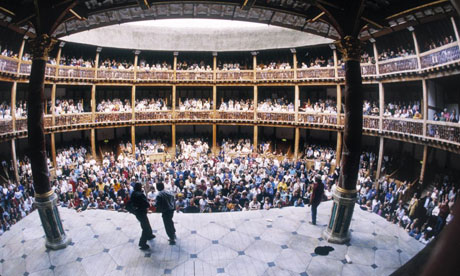Globe Theatre London

Essays received: Zadejiah, Hiedi, Miranda, Aaron, Nick
Due at the beginning of class: critical lens paper on Hamlet. This is the last grade for this marking period.
In class: the film
Homework: for Thursday, please have read carefully the background material on American literature before 1750. There are only two pages. Please note the attitude expressed in the opening verse by Thomas Dale, the type of literary tradition of the Indians, the purpose of the New England settlement, predestination (how does it differ from fate (you know that from Hamlet), the literary style of the Pilgrims and William Byrd. Copy below. Expect a quiz on Thursday.
Wednesday: psat....bring your calculators
The New Land to 1750
Let England
For that our worke is good:
Wee hope to plant a nation,
Where none before hath stood
Thomas Dale
Governor of the Jamestown
More than a century after European explorers discovered North America, there were no permanent settlements in the New World north of St. Augustine , Florida Virginia Jamestown
The first settlers were entranced by the presence and, to them, the strangeness of the native inhabitants. They did not at first realize that these earlier Americans, like Europeans, had cultural values and literary traditions of their own. The literature was entirely oral, for the tribes of North America had not yet developed writing systems. This extensive oral tradition, along with the first written works of the colonists forms the beginning of the American literary heritage.
When Christopher Columbus reached North America in 1492, the continent was already populated, though sparsely, by several hundred Native American tribes. Europeans did not encounter these tribes all at once. Explorers from different nations came into contact with them at different times. As we now know, these widely dispersed tribes of Native Americans differed greatly from one another in language, government, social organization, customs, housing and methods of survival.
What we do know is that the Native Americans usually, but by no means always, greeted the earliest Europeans as friends. They instructed the newcomers in New World agriculture and woodcraft, introduced them to maize, beans, squash, maple sugar, snow shoes, toboggans and birch bark canoes.
A small group of Europeans sailed from England Plymouth , Massachusetts
Religion affected every aspect of Puritan life, although the Puritans were not always as stern and otherworldly as they are sometimes pictures. Their writings occasionally reveal a sense of humor, and the hardships of daily life forced them to be practical. In one sense, the Puritans were radical, since they demanded fundamental changes in the Church of England. In another sense, however, they were conservative. They preached a plain, unadorned Christianity that contrasted sharply with the cathedrals, vestments, ceremony and hierarchy of the Church of England.
What exactly did the puritans believe? Their beliefs were far from simple, but they agreed that human beings exist for the glory of God and the Bible is the sole expression of God’s will. They believed in predestination--John Calvin’s doctrine that God has already decided who will achieve salvation and who will not. The elect, or saints, who are to be saved, cannot take election for granted, however. Because of that, all devout Puritans searched their soul with great rigor and frequency for signs of grace. The Puritans believed in original sin and felt that they could accomplish good only through continual hard work and self-discipliner. When people speak of the “Puritan ethic,” that is what they mean.
It was an oddly assorted group that established the foundations of American literature: the Native Americans with their oral traditions, the Puritans with their preoccupation with sin and salvation and the Southern planters with their busy social lives. Indeed, much of the literature that the colonists read was not produced in the colonies. It came from England
Note: The Puritans in general had a theory of literary style. They believed in the plain style of writing, one in which clear statement is the highest goal. An ornate or clever style would be a sign of vanity and, as such, would not be in accordance with God’s will.
The important literature of the pre-Revolutionary South can be summed up in one name-William Byrd. Byrd lived at Westover, a magnificent plantation on the James River bequeathed to him by his wealthy father. Commissioned in 1738 to survey the boundary line between Virginia and North Carolina
No comments:
Post a Comment